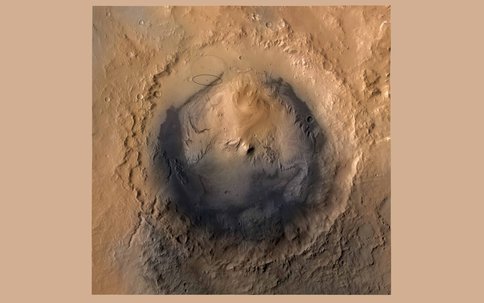2012 Annual Science Report
 Massachusetts Institute of Technology
Reporting | SEP 2011 – AUG 2012
Massachusetts Institute of Technology
Reporting | SEP 2011 – AUG 2012
Astrobiological Exploration of Mars
Project Summary
MIT Team member John Grotzinger is the Project Scientist of the MSL mission currently underway at Gale Crater on Mars. John, and his team at Caltech, led a major study of potential landing sites which resulted in the selection of Gale Crater. Since then, they have been involved in the Gale Imaging Working Group, which has been identifying key HiRISE and CRISM data products, which will enhance the science mission. Several members of the Grotzinger group have also been involved in creating a geologic map of the landing site. This involves mapping 1.5° square quads in the landing ellipse and nearby areas. Since landing, the mapping focus has shifted from compiling a regional map to understanding the details of the units and geological relationships in the immediate vicinity of Curiosity.
Project Progress
The Mars Science Laboratory (MSL) mission has four primary science objectives for looking at habitable environments: assess the biological potential of at least one target environment by determining the nature and inventory of organic carbon compounds; characterize the geology of the landing region at all appropriate spatial scales by investigating the chemical, isotopic, and mineralogical composition of the surface and near-surface materials; investigate planetary processes of relevance to past habitability, including the role of water and carbon dioxide; and characterize the broad spectrum of surface radiation (MSL website). MSL is not a life-detection mission, but it will be able to detect complex organic molecules in rocks and soils, which could be of biological origin, or from carbonaceous meteorites (Grotzinger, 2009).
At Caltech, MSL Project Scientist John Grotzinger, staff scientist Jennifer Griffes, and graduate student Katie Stack, have all been working on landed operations since the Curiosity safely touched down in Gale crater on August 5, 2012. Roger Summons has also been working at JPL during landed operations as a participating scientist on the SAM Instrument team.
Gale has a diverse stratigraphy within a 5 km high central mound in the crater. There are well-defined beds of hydrated minerals including sulfates and phyllosilicates, some of which are interbedded. This could represent changing environmental conditions during deposition. Discussions of past environmental conditions on Mars brings into context important concepts of astrobiology including what is known about the capacity of life, as we know it, to exist in Martian environments. Slightly higher in the lower mound, there are cemented fractures, evidence that there was once groundwater to at least that height on the mound. Within the landing ellipse, there are variations in thermal inertia, including a high thermal inertia fan sourced from the crater rim.
We have also been involved in the Gale Imaging Working Group, which has been identifying key HiRISE and CRISM data products, which will enhance our science mission at Gale crater. The ellipse and lower mound (where the rover will traverse) were successfully targeted by HiRISE and CRISM and high resolution digital elevation models (DEMs) were created, along with super high resolution CRISM mineralogical data. This has been used for science analysis and traversability studies, as well as Katie’s bed thickness project (see below).
Several members of the Grotzinger group have also been involved in creating a geologic map of the landing site. This involves mapping 1.5° square quads in the landing ellipse and nearby areas. Since landing, the mapping focus has shifted from compiling a regional map to understanding the details of the units and geological relationships in the immediate vicinity of Curiosity. Understanding as much as we can of that area and developing alternative hypotheses to test will greatly facilitate the decision making process for where the rover will stop on its way to Mt. Sharp.
Katie has continued work measuring the distribution of bed thickness in sedimentary deposits on Mars using orbital imagery. The goal of this work is to develop semi-quantitative orbital methods for distinguishing and classifying Martian sedimentary deposits. This work is complimented by an ongoing effort to build a global inventory of Martian sedimentary layered rocks. This database will be useful for identifying interesting targets for future landing site selection, as well as in depth studies of sedimentary depositional environments and habitability on Mars.
Team members Andrew Knoll and John Grotzinger continue to serve on the science team for the MER Mars mission. A recent Science paper (Squyres et al., 2012) documents progress up to early 2012, including the discovery of gypsum veins that document ground waters of moderate temperature and water activity. Ongoing exploration, to which Knoll contributes regularly, has identified an entirely new terrain for Opportunity. Knoll and Grotzinger will continue to work with other MER team members to understand the potentially clay-rich rocks that lie stratigraphically beneath the sulfate-rich sandstones traverse for years by opportunity and exposed along the lip of Endeavour crater.
Curiosity’s landing site at the base of Mt Sharp, Gale Crater on Mars. Image Credit: NASA/JPL-Caltech
Publications
-
Grotzinger, J. P., Crisp, J., Vasavada, A. R., Anderson, R. C., Baker, C. J., Barry, R., … Wiens, R. C. (2012). Mars Science Laboratory Mission and Science Investigation. Space Sci Rev, 170(1-4), 5–56. doi:10.1007/s11214-012-9892-2
-
Squyres, S. W., Arvidson, R. E., Bell, J. F., Calef, F., Clark, B. C., Cohen, B. A., … Zacny, K. (2012). Ancient Impact and Aqueous Processes at Endeavour Crater, Mars. Science, 336(6081), 570–576. doi:10.1126/science.1220476
- Grotzinger, J.P. & Milliken, R.E. (2012). The sedimentary rock record of Mars: distribution, origins, and global stratigraphy,. In: Grotzinger, J.P. & Milliken, R.E. (Eds.). SEPM Special Paper.
-
PROJECT INVESTIGATORS:
-
PROJECT MEMBERS:
Jeniffer Griffes
Research Staff
Kathryn Stack
Doctoral Student
-
RELATED OBJECTIVES:
Objective 1.1
Formation and evolution of habitable planets.
Objective 2.1
Mars exploration.

